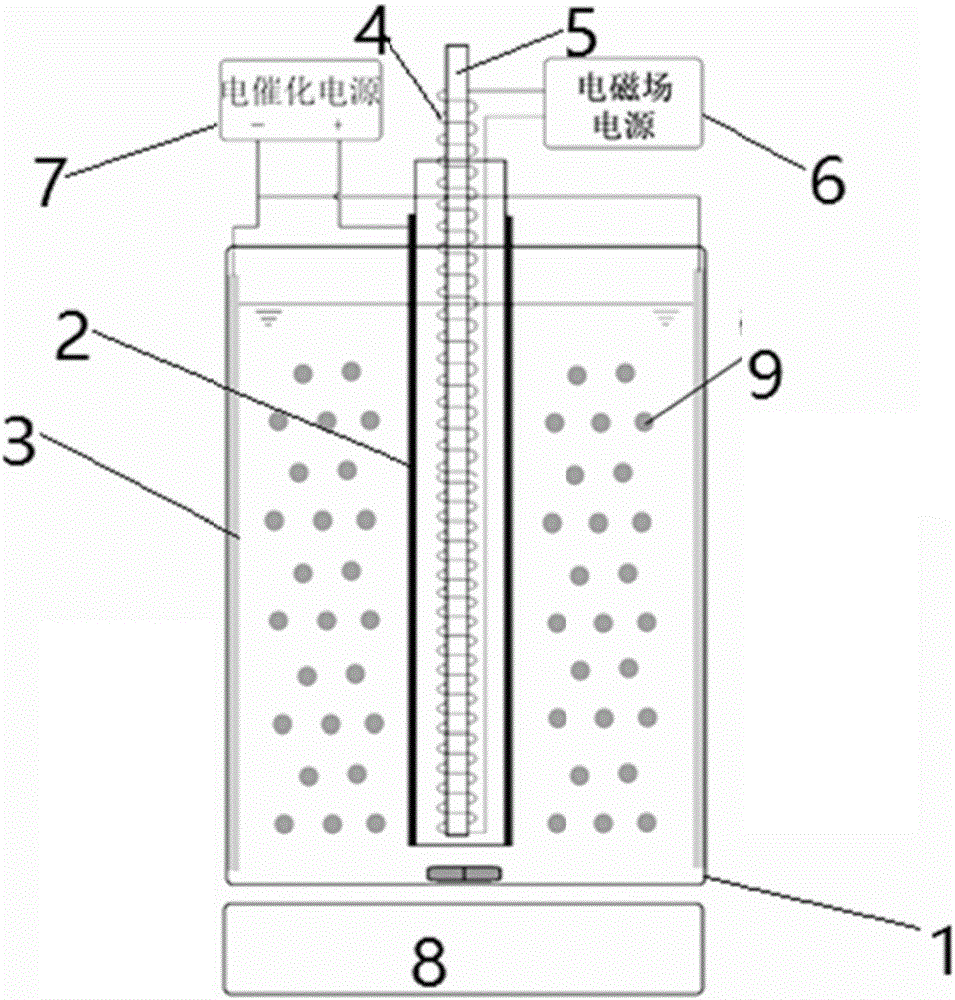In-situ adsorption and electrocatalysis coupled organic wastewater treatment system and method
A technology for organic wastewater treatment and electrocatalysis, applied in the fields of adsorption water/sewage treatment, magnetic field/electric field water/sewage treatment, water/sewage treatment, etc., can solve the problems of waste, low apparent catalytic efficiency, etc., and prolong the service life. , The effect of improving electrocatalytic degradation performance and low energy consumption
- Summary
- Abstract
- Description
- Claims
- Application Information
AI Technical Summary
Problems solved by technology
Method used
Image
Examples
Embodiment 1
[0037] Embodiment 1: Non-attraction type, that is, the electromagnetic field is always disconnected. In this state, due to the agitation in the electrolytic cell, the adsorbent particles are in a fluidized state and suspended in the solution to be treated. At this time, the adsorbent particles will adsorb the organic molecules in the solution to be treated, and then the mass transfer process of the organic molecules from the solution body to the electrode surface is completed through the collision between the adsorbent particles and the electrode surface in a fluidized state. When the electrocatalytic electrode is energized, the organic molecules brought by the adsorbent molecules to the electrode / solution interface undergo an oxidation reaction with the OH on the electrode surface to complete the degradation process.
Embodiment 2
[0038] Embodiment 2: direct attraction type, that is, the electromagnetic field of the electromagnet always exists or a permanent magnet is used. The magnetic adsorbent particles are always adsorbed on the surface of the electrode, forming a transitional electrode system (2.5-dimensional system) between the 2-dimensional and 3-dimensional systems. In this case, the adsorbent particle layer on the electrode surface will greatly expand the actual surface area of the electrode, thereby creating an enrichment field of organic molecules between the electrode surface and the solution body, so that the organic molecules are continuously released from the solution body. Migration enrichment towards the electrode surface. When organic molecules continuously enter the interface, the probability of contact reaction between the surface adsorbed OH and organic molecules increases, the utilization rate of OH increases, the side reaction of oxygen evolution is suppressed, the current effic...
Embodiment 3
[0039] Embodiment 3: Pulse attraction type, that is, the electromagnetic field of the electromagnet is switched on and off at a certain frequency, so that the magnetic adsorbent travels back and forth between the solution body and the electrode surface at the same frequency. When the electromagnetic field is disconnected, the magnetic adsorbent detaches from the electrode surface. Due to the stirring effect in the electrolytic cell, the adsorbent particles are in a fluidized state and suspended in the solution to be treated. At this point, the adsorbent particles will adsorb the organic molecules in the solution to be treated. When the electromagnetic field is turned on, the magnetic adsorbent particles are adsorbed on the electrode surface. At this time, the adsorbent particles will release the organic molecules adsorbed in the solution body due to the influence of the acidic environment on the electrode surface, completing the desorption and regeneration process. The organi...
PUM
 Login to View More
Login to View More Abstract
Description
Claims
Application Information
 Login to View More
Login to View More - R&D
- Intellectual Property
- Life Sciences
- Materials
- Tech Scout
- Unparalleled Data Quality
- Higher Quality Content
- 60% Fewer Hallucinations
Browse by: Latest US Patents, China's latest patents, Technical Efficacy Thesaurus, Application Domain, Technology Topic, Popular Technical Reports.
© 2025 PatSnap. All rights reserved.Legal|Privacy policy|Modern Slavery Act Transparency Statement|Sitemap|About US| Contact US: help@patsnap.com


